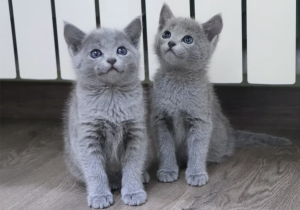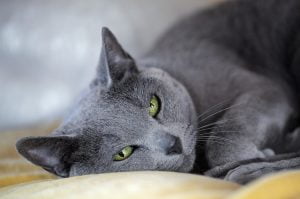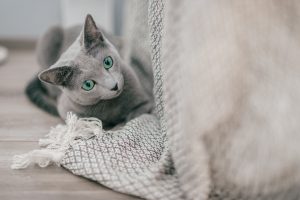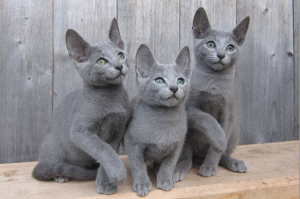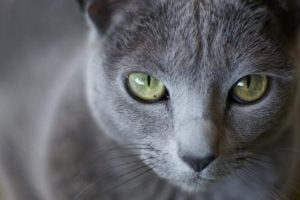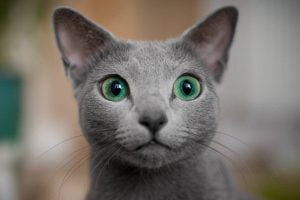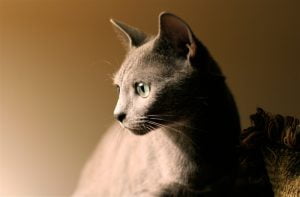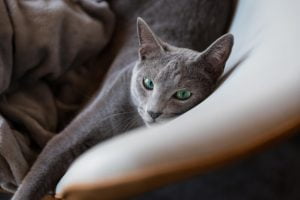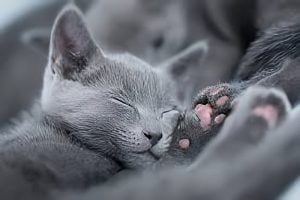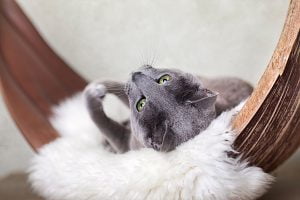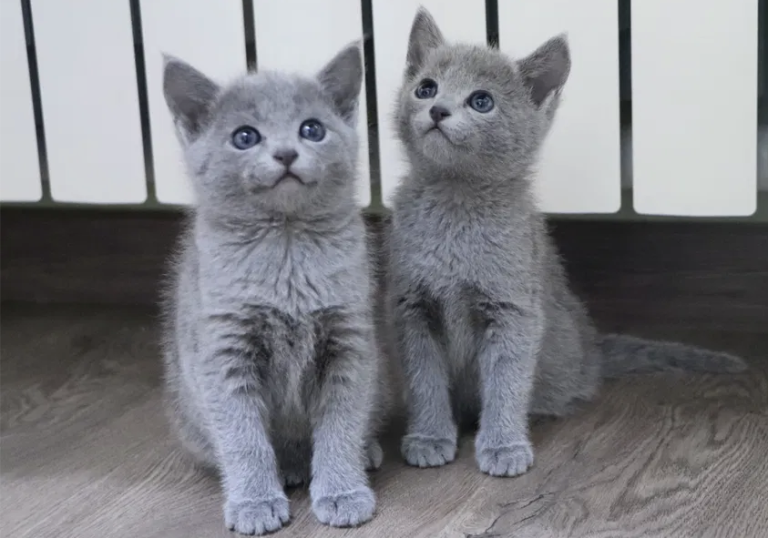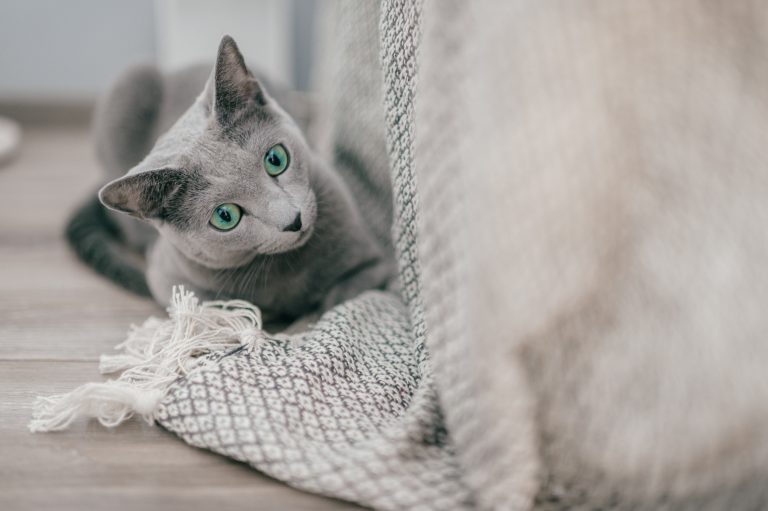Welcome to our article comparing two of the most popular cat breeds: Russian Blue and British Shorthair. Both breeds are beloved by cat lovers around the world for their unique features and personalities. In this article, we will explore the similarities and differences between these two breeds, and help you decide which one might be the best fit for your home and lifestyle. Whether you’re a first-time cat owner or an experienced feline enthusiast, this article will provide you with all the information you need to make an informed decision. So let’s dive in!
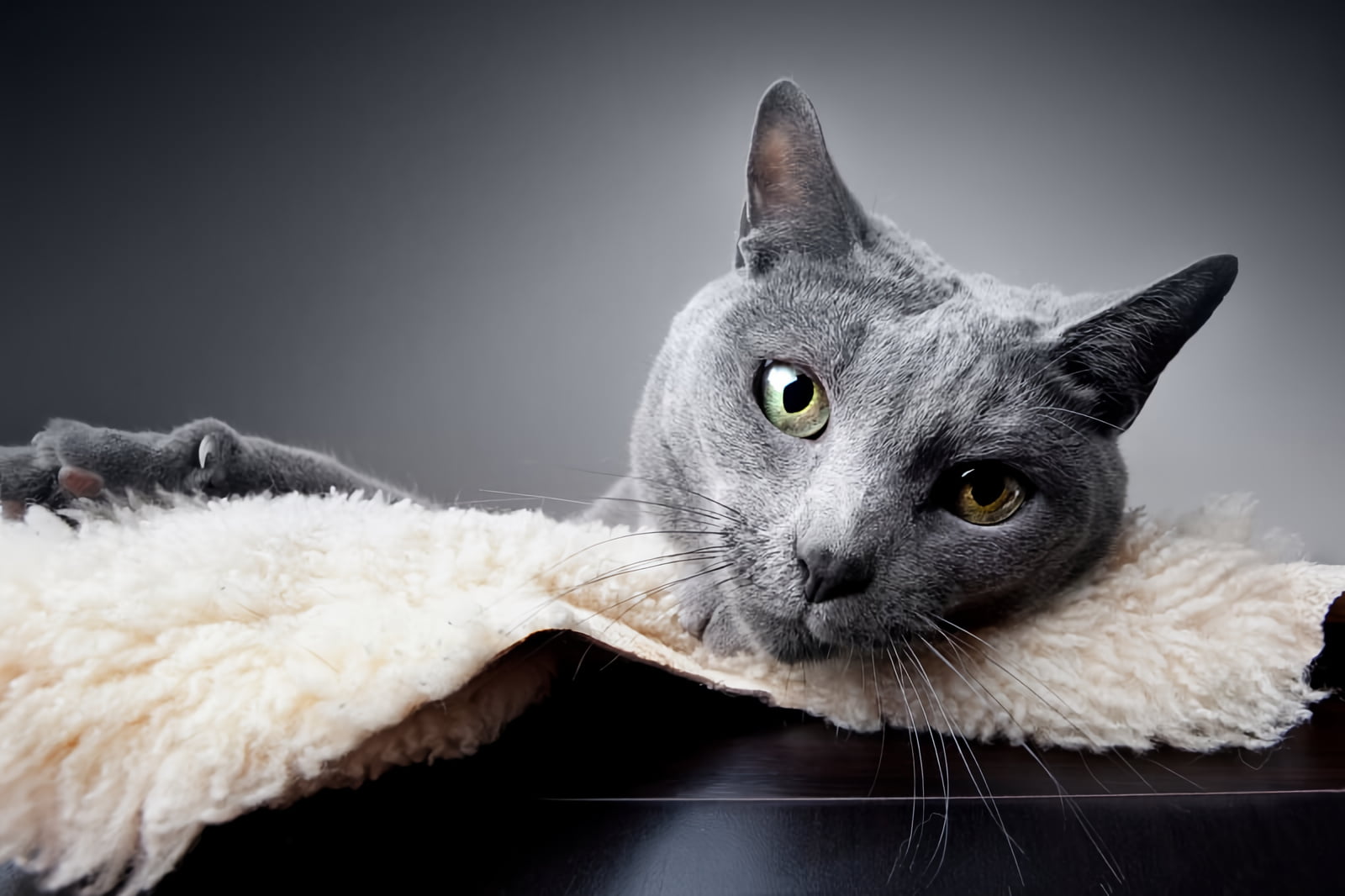
Appearance
Russian Blue cats and British Shorthair cats have distinct physical characteristics that set them apart from one another. Here’s a closer look at the appearance of each breed:
Russian Blue:
- Coat type: The Russian Blue has a dense, plush double coat that’s soft to the touch. The fur is typically blue-gray in color and has a sheen that gives it a silvery appearance.
- Size and shape: Russian Blues are medium-sized cats with a muscular build and a lean, elegant appearance. They have a wedge-shaped head with large, almond-shaped green eyes and long, pointed ears.
British Shorthair:
- Coat type: The British Shorthair has a short, dense coat that’s plush and velvety to the touch. They come in a variety of colors and patterns, including blue, black, white, cream, and tabby.
- Size and shape: British Shorthairs are large, sturdy cats with a round, cobby build. They have a broad, round face with large, round eyes and small, round-tipped ears.
While there are some similarities between the two breeds, there are also some key differences in their appearance. For example:
- Coat color: While both breeds can come in shades of blue, the Russian Blue is known for its signature blue-gray coat, while the British Shorthair comes in a wider variety of colors and patterns.
- Body shape: Russian Blues have a more elongated, streamlined body shape, while British Shorthairs are more compact and round.
- Ear shape: Russian Blues have long, pointed ears that are set high on their head, while British Shorthairs have small, rounded ears that are set lower on their head.
Overall, both breeds are stunning in their own way, with unique features that make them stand out from other cat breeds. When choosing between the two, it’s important to consider your personal preferences for appearance and which one might fit best in your home.
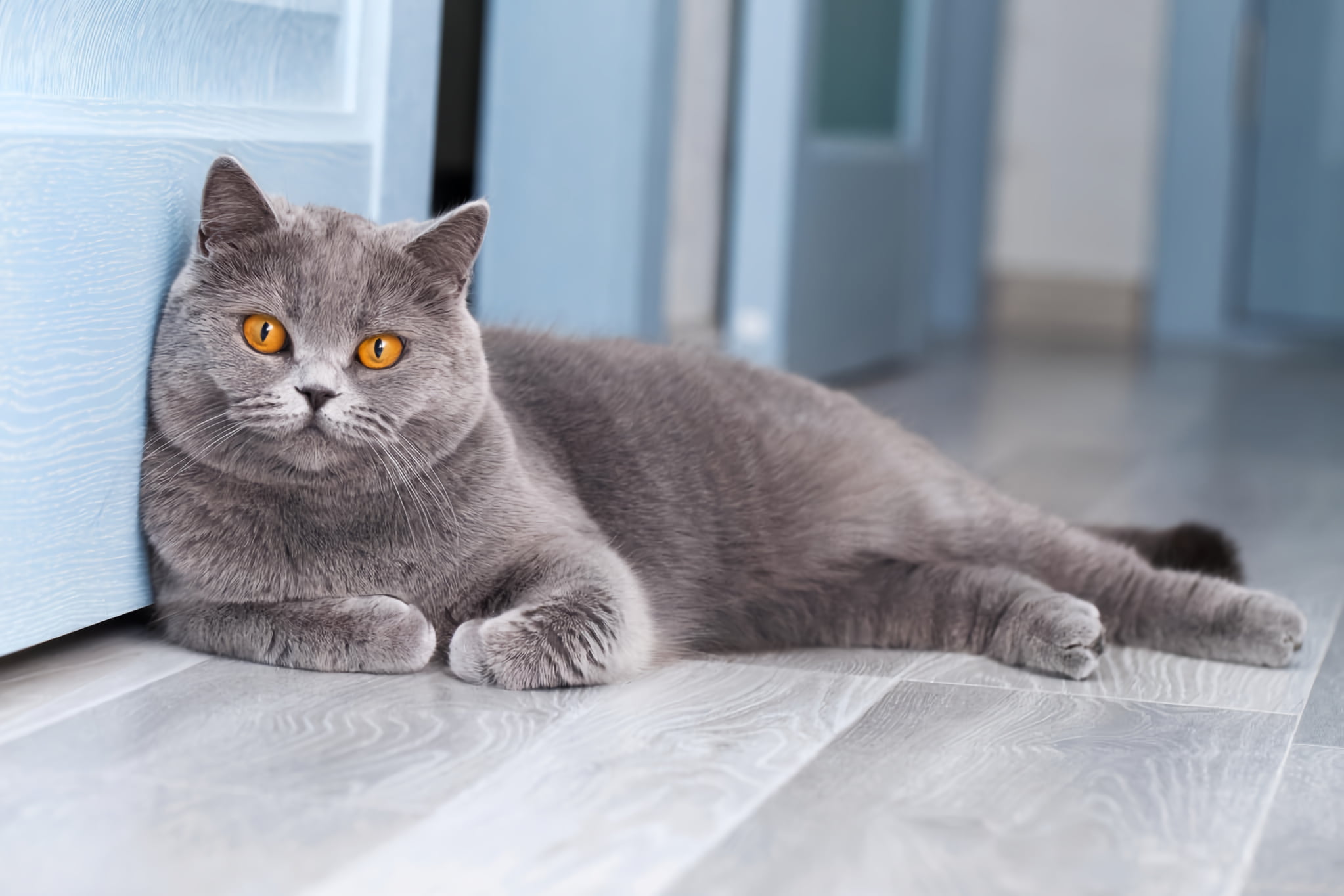
Personality
When it comes to personality, Russian Blue cats and British Shorthair cats have distinct characteristics that make them unique. Here’s a closer look at the personality traits of each breed:
Russian Blue:
- Playfulness: Russian Blues are active and playful cats that love to engage in games and physical activities.
- Affection: Russian Blues are known for being affectionate and loyal towards their owners. They tend to bond closely with one or two people and can be shy or reserved around strangers.
- Independence: While they enjoy human company, Russian Blues also value their alone time and may retreat to a quiet spot in the house for some alone time.
- Sociability: Russian Blues can be selective about their company and may not always get along with other cats or pets in the household.
British Shorthair:
- Playfulness: British Shorthairs are generally more laid-back and less active than Russian Blues. They enjoy playtime, but tend to be more low-key in their activities.
- Affection: British Shorthairs are known for being affectionate and loving towards their owners. They tend to form strong bonds with their family and enjoy spending time with them.
- Independence: While they enjoy human company, British Shorthairs also value their independence and may not crave attention as much as other breeds.
- Sociability: British Shorthairs tend to be more social and adaptable to new environments and people. They usually get along well with other cats and pets in the household.
When comparing the two breeds, it’s clear that Russian Blues tend to be more active and affectionate towards their owners, while British Shorthairs are more laid-back and social. Both breeds are intelligent and curious, but may have different needs when it comes to playtime, attention, and socialization. It’s important to consider your lifestyle and preferences when choosing between the two breeds to ensure that you can provide the best home for your feline friend.
Health
Russian Blue cats and British Shorthair cats are generally healthy breeds with a long lifespan. However, like all cats, they can be prone to certain health issues. Here’s a look at the common and unique health concerns for each breed:
Common Health Issues:
- Urinary tract infections: Both breeds are prone to urinary tract infections, which can be caused by a number of factors, including stress, diet, and dehydration. Signs of a UTI include frequent urination, straining to urinate, and blood in the urine.
- Dental problems: Dental issues such as periodontal disease and tooth decay can be common in both breeds, especially as they age. Regular dental checkups and teeth cleanings can help prevent these issues.
Russian Blue:
- Hypertrophic cardiomyopathy: Russian Blues are at a higher risk for hypertrophic cardiomyopathy, a heart disease that causes the thickening of the heart muscles. Symptoms may include lethargy, difficulty breathing, and a loss of appetite.
- Asthma: Russian Blues may be more prone to developing asthma, which can cause coughing, wheezing, and difficulty breathing. Avoiding triggers such as cigarette smoke and dust can help manage this condition.
British Shorthair:
- Polycystic kidney disease: British Shorthairs are at a higher risk for polycystic kidney disease, a genetic condition that causes the formation of cysts in the kidneys. Symptoms may include vomiting, weight loss, and increased thirst.
- Obesity: British Shorthairs have a tendency to become overweight if they’re not given enough exercise and a balanced diet. Regular exercise and portion control can help manage this condition.
Prevention and Management: To prevent or manage health issues in both breeds, it’s important to provide them with a healthy diet, regular exercise, and regular veterinary checkups. It’s also important to monitor their behavior and look out for any signs of illness or discomfort. If you suspect that your cat may have a health issue, it’s important to seek veterinary care as soon as possible.
Care and maintenance
Russian Blue cats and British Shorthair cats have different grooming needs, dietary requirements, exercise needs, and special care considerations. Here’s a closer look at each category:
Grooming:
- Russian Blue: The Russian Blue’s short, dense coat requires minimal grooming. Brushing once a week can help remove loose hair and distribute natural oils in the coat. Regular nail trimming and teeth brushing are also important for overall health and hygiene.
- British Shorthair: The British Shorthair’s dense, plush coat requires regular brushing to prevent matting and tangling. Weekly grooming is recommended, with extra brushing during shedding season. Regular nail trimming and teeth brushing are also important for overall health and hygiene.
Dietary requirements:
- Russian Blue: The Russian Blue’s dietary needs are similar to most cats. A balanced diet that’s rich in protein and low in carbohydrates is recommended. Wet food or a combination of wet and dry food can help prevent urinary tract issues.
- British Shorthair: The British Shorthair’s dietary needs are similar to the Russian Blue’s. A balanced diet that’s rich in protein and low in carbohydrates is recommended. Wet food or a combination of wet and dry food can help prevent obesity and urinary tract issues.
Exercise needs:
- Russian Blue: The Russian Blue is an active breed that enjoys playtime and exercise. Interactive toys and scratching posts can help keep them mentally and physically stimulated.
- British Shorthair: The British Shorthair is a less active breed that enjoys a relaxed lifestyle. Short play sessions and daily exercise, such as chasing a toy or climbing a scratching post, can help keep them healthy and happy.
Special care considerations:
- Russian Blue: Russian Blues may be prone to stress and anxiety, so creating a calm and peaceful environment is important. They may also need extra attention and affection to feel secure and comfortable.
- British Shorthair: British Shorthairs may be prone to obesity, so monitoring their diet and exercise is important. They may also be prone to joint issues as they age, so providing comfortable resting spots and avoiding high-impact activities can help prevent injuries.
Overall, both breeds require similar care and maintenance, with some differences in grooming needs, exercise requirements, and special care considerations. Providing a healthy diet, regular exercise, and plenty of love and attention can help keep your feline friend healthy and happy.
Cost
When considering owning a cat, it’s important to factor in the costs associated with adoption or purchase, veterinary care, food and supplies, and ongoing expenses. Here’s a breakdown of the typical costs associated with owning a Russian Blue or British Shorthair cat:
Adoption or Purchase:
- Adoption fees for a Russian Blue can range from $75 to $200, depending on the shelter or rescue organization.
- Adoption fees for a British Shorthair can range from $150 to $500, depending on the shelter or rescue organization.
- Purchasing a Russian Blue from a breeder can cost between $500 to $2,000 or more, depending on the quality of the breed and the breeder’s reputation.
- Purchasing a British Shorthair from a breeder can cost between $1,000 to $2,500 or more, depending on the quality of the breed and the breeder’s reputation.
Veterinary Costs:
- Initial veterinary costs for a new cat can include vaccinations, spaying or neutering, and a general health checkup. These costs can range from $100 to $300, depending on the location and the services provided.
- Ongoing veterinary costs for routine checkups and preventative care can cost around $200 to $300 per year.
- Unexpected veterinary costs for illnesses or injuries can vary greatly, depending on the severity of the condition and the required treatments. These costs can range from several hundred dollars to thousands of dollars.
Food and Supplies:
- Food costs for a Russian Blue or British Shorthair can vary depending on the brand and type of food. Expect to spend around $20 to $40 per month on high-quality cat food.
- Litter and litter box costs can range from $10 to $20 per month.
- Toys, scratching posts, and other supplies can cost anywhere from $50 to $100 initially, with ongoing costs for replacement and upkeep.
Overall, the cost of owning a Russian Blue or British Shorthair can vary depending on a number of factors, including where you live, the level of veterinary care required, and your preferences for food and supplies. It’s important to budget for the ongoing costs of cat ownership and to be prepared for unexpected expenses that may arise. If you’re considering purchasing from a breeder or cattery, be sure to do your research and choose a reputable breeder who prioritizes the health and well-being of their cats.
Conclusion
In conclusion, Russian Blue cats and British Shorthair cats are both wonderful breeds with unique characteristics and traits. Here’s a summary of the similarities and differences between the two breeds:
Similarities:
- Both breeds are generally healthy and have a long lifespan.
- Both breeds require a healthy diet, regular exercise, and routine veterinary care.
- Both breeds can be affectionate and loving towards their owners.
Differences:
- Russian Blues tend to be more active and playful, while British Shorthairs are more laid-back and social.
- Russian Blues may require more attention and affection, while British Shorthairs may be more independent.
- Russian Blues may be more prone to stress and anxiety, while British Shorthairs may be more prone to obesity.
When deciding between the two breeds, it’s important to consider your personal preferences and lifestyle. If you’re looking for a more active and playful cat, a Russian Blue may be the best fit. If you’re looking for a more laid-back and social cat, a British Shorthair may be the way to go. It’s also important to consider any potential health issues or special care needs that each breed may have. Ultimately, the best way to make a decision is to spend time with both breeds and see which one you connect with the most.
Regardless of which breed you choose, owning a cat can be a wonderful and rewarding experience. With proper care, love, and attention, your feline friend can provide you with years of companionship and joy.

